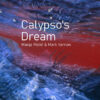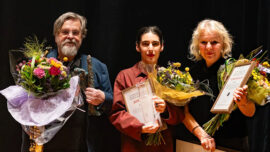
Calypso’s Dream is s collection of soundscapes made by Serbian sound artist Manja Ristić and Scottish sound artist Mark Vernon who sculpted sonic morphologies of the micro-environments of the Croatian island of Mljet in the South Adriatic Sea, one of the oldest European protected natural zones.
In the Greek mythology, Calypso was a beautiful nymph who lived on the fictional island of Ogygia, where, according to Homer’s Odyssey, she detained Odysseus for seven years against his will, wanting to marry him. Calypso promised Odysseus immortality if he would stay with her, but Odysseus preferred to return to his home in Ithaca. Eventually, after the intervention of the other gods, Calypso is forced to let Odysseus go. «Cruel folk you are, unmatched for jealousy, you gods who cannot bear to let a goddess sleep with a man», Calypso answered to Hermes, the herald of the gods, who ordered her to release Odysseus.
Calypso’s Dream attempts to offer a conceptual-symbolic sonic counterpoint, a critical, gender approach to Homer’s Odyssey and a critical reflection on the commercial appropriation of tourist attractions such as Odysseus’s Cave in Babino Polje in southern Croatia, where Odysseus was supposedly held captive. Ristić and Vernon were inspired by the work of renowned Canadian writer-poet Margaret Atwood, who wrote The Penelopiad (2005), where she tried to unravel the archetypal mystery by narrating the Odyssey from the perspective of Odysseus’s wife, Penelope, who was left for twenty years to defend the Ithaca kingdom and raise their children.
Calypso’s Dream suggests Calypso’s perspective to the ancient myth, through nuanced yet suggestive-cinematic sound art, woven from the dense spectrum of the island of Mljet’s rich and unique biophony, with sparse, atmospheric layers. This thoughtful, enigmatic sound art insists that the history of this region is much more complex than the one told in Homer’s myth. Furthermore, the tourism of the southern Adriatic is its own kind of Odyssey, marked by numerous shipwrecks, losses, and devastation, directly affecting the environment that has been shaped over millennia.
Ristić and Vernon claim that too often we fail to listen. Therefore Calypso’s Dream is guided by the concept of mnemosonics — listening to the memory of places, an exploration of the subtle sonic identity of the island of Mljet, with an emphasis on its lakes and forested areas, and some karst pits, using hydrophone recording techniques, field recording, found sounds and the amplification of found objects. The album includes text and photos by Ristić on the history and the biodiversity of the island.
Eyal Hareuveni
Manja Ristić (field recordings, electronics), Mark Vernon (field recordings, electronics)




































